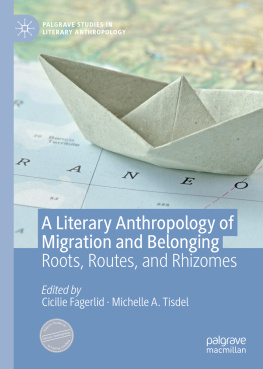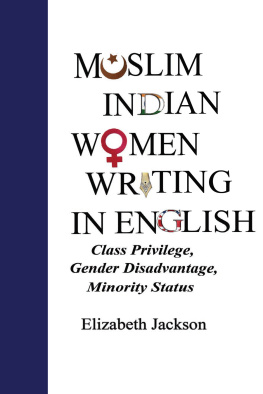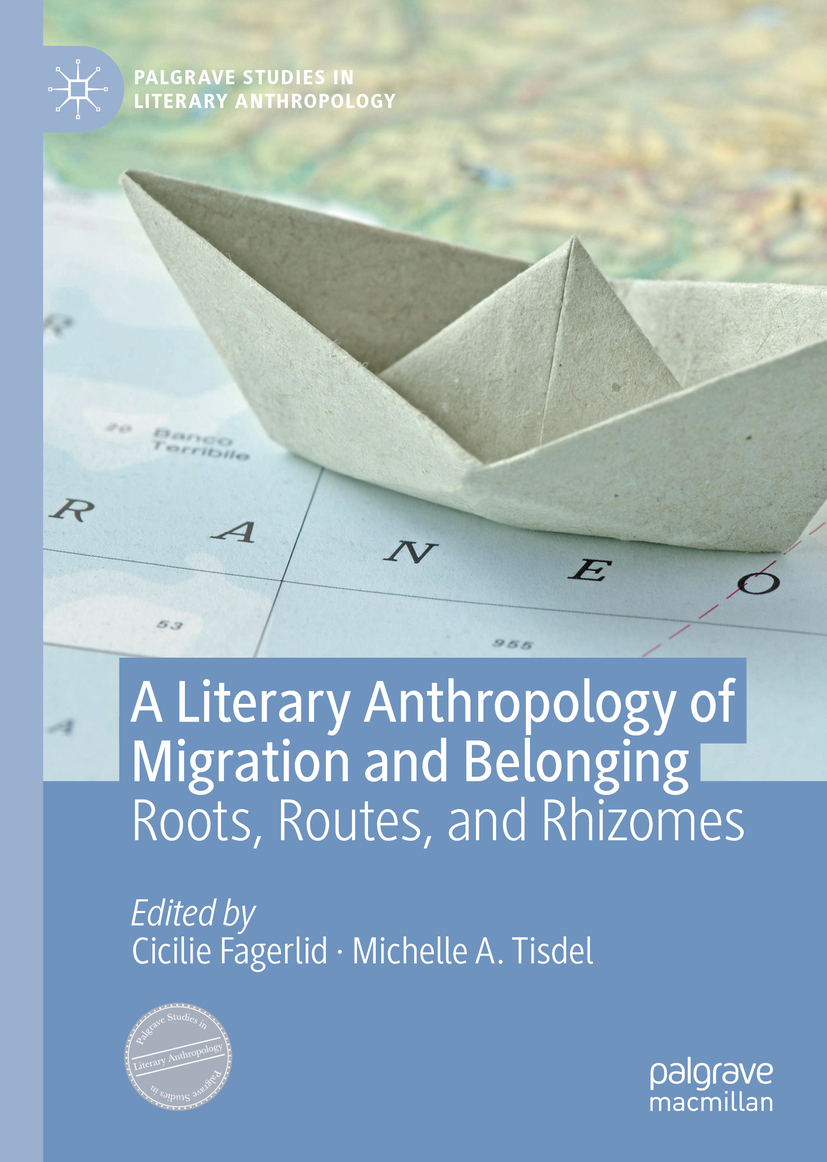Palgrave Studies in Literary Anthropology
Series Editors
Deborah Reed-Danahay
Department of Anthropology, The State University of New York at Buffalo, Buffalo, NY, USA
Helena Wulff
Department of Social Anthropology, Stockholm University, Stockholm, Sweden
This series explores new ethnographic objects and emerging genres of writing at the intersection of literary and anthropological studies. Books in this series are grounded in ethnographic perspectives and the broader cross-cultural lens that anthropology brings to the study of reading and writing. The series explores the ethnography of fiction, ethnographic fiction, narrative ethnography, creative nonfiction, memoir, autoethnography, and the connections between travel literature and ethnographic writing.
More information about this series at http://www.palgrave.com/gp/series/15120
Editors
Cicilie Fagerlid and Michelle A. Tisdel
A Literary Anthropology of Migration and Belonging
Roots, Routes, and Rhizomes
Editors
Cicilie Fagerlid
Oslo Metropolitan University, Oslo, Norway
Michelle A. Tisdel
National Library of Norway, Oslo, Norway
Palgrave Studies in Literary Anthropology
ISBN 978-3-030-34795-6 e-ISBN 978-3-030-34796-3
https://doi.org/10.1007/978-3-030-34796-3
Chapter 4 is licensed under the terms of the Creative Commons Attribution 4.0 International License (http://creativecommons.org/licenses/by/4.0/). For further details see license information in the chapter.
The Editor(s) (if applicable) and The Author(s), under exclusive license to Springer Nature Switzerland AG 2020
This work is subject to copyright. All rights are solely and exclusively licensed by the Publisher, whether the whole or part of the material is concerned, specifically the rights of translation, reprinting, reuse of illustrations, recitation, broadcasting, reproduction on microfilms or in any other physical way, and transmission or information storage and retrieval, electronic adaptation, computer software, or by similar or dissimilar methodology now known or hereafter developed.
The use of general descriptive names, registered names, trademarks, service marks, etc. in this publication does not imply, even in the absence of a specific statement, that such names are exempt from the relevant protective laws and regulations and therefore free for general use.
The publisher, the authors and the editors are safe to assume that the advice and information in this book are believed to be true and accurate at the date of publication. Neither the publisher nor the authors or the editors give a warranty, expressed or implied, with respect to the material contained herein or for any errors or omissions that may have been made. The publisher remains neutral with regard to jurisdictional claims in published maps and institutional affiliations.
Cover illustration: CalypsoArt / Alamy Stock Photo
This Palgrave Macmillan imprint is published by the registered company Springer Nature Switzerland AG.
The registered company address is: Gewerbestrasse 11, 6330 Cham, Switzerland
Foreword
Diversity has been an inherent feature of many societies across the world. Yet with recent mass movement of migrants and refugees, ethnic diversity has increased dramatically, even in societies that used to be virtually homogeneous. This produces a new spectrum of subjectivities of belongingranging from a variety of ways of belonging to one place, to a sense of belonging to two (or even more) places.
The volumeA Literary Anthropology of Migration and Belonging. Roots, Routes, and Rhizomes, edited by Cicilie Fagerlid and Michelle Tisdel, is imperative for an understanding of contemporary society, as characterized by increasing diversity on a global scale. The volume is a pitch-perfect example of the social impact of literature. It features a substantial introduction by the editors, followed by a number of strong chapters discussing different literary cases of migrant narratives in cultural and social contexts. The take here is that hybrid encounters have the potential to release individual and social transformation. Without denying the existence of grim realities of outsiderness, the volume also identifies instances of integration through literature, not least in a younger generation that was born in the new country, or moved there as children. Once again, the anthropological approach reveals a major aspect of societyfrom a minor perspective. Key in this nuanced volume is that migrant narratives in literature convey a palette of diversity, rather than a binary situation.
After a brief account of the development of literary anthropology, also in relation to methodological strategies, I will, in what follows, consider the role of movement and autobiography in social life and literature. This leads over to the point that migrant narratives can facilitate emplacement.
Anthropologists have been inspired by literature, to varying extents, for almost as long as the discipline has existed. A more systematic attention to literature in anthropology emerged in the 1970s with Victor Turner (1976), who was trained in comparative literature. As new topics of anthropological study eventually were identified, ranging from transnational occupational cultures to policy documents and internet use, a wider array ofmethodological strategieswere required: multi-local fieldwork, ethnographic interviews, close readings of various textual genres, as well as media, press (features and reviews), and digital materials (including YouTube clips and other visual materials) were added to the traditional one-year participant observation. As participant observation was not always the most useful option anymore, the main method for many contemporary studies has been ethnographic interviews, close readings of various textual genres, or internet materials. The anthropological study of fellow intellectuals and writers can be captured by the notion of studying sideways as suggested by Ulf Hannerz (2004) in his study of foreign correspondents. This is thus also relevant for research focusing on literary production, such as my own on Irish literature (Wulff 2017). Now literary anthropology is established and flourishing.
In a review essay in
Ethnography, writer-cum-anthropologist Ellen Wiles (2018, p. 2) describes literary anthropology as a central stem with three branches:
The first is the use of literary texts as ethnographic source material, particularly for historical anthropologists. The second is the use of literary modes of writing ethnography, ranging from the incorporation of metaphorical language and the subversion of conventional ethnographic structures to the production of fiction as ethnography. The third is the anthropological examination of literary cultural and production practices.
Some of these branches can obviously grow together. In my current study of migrant writing in Sweden (Wulff 2018a, b, 2019), I combine the use of literary texts as ethnographic source material with the anthropological examination of literary cultural and production practices. When it comes to the production of fiction as ethnography an early, possibly even the very first, example of this is









